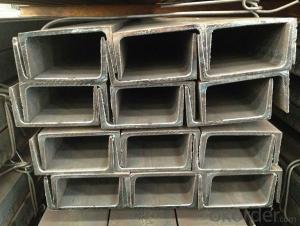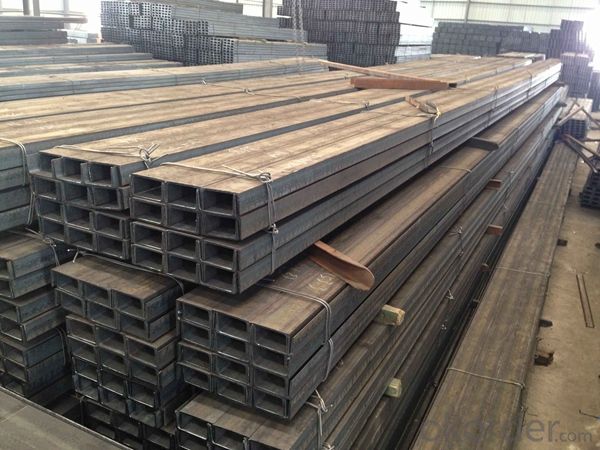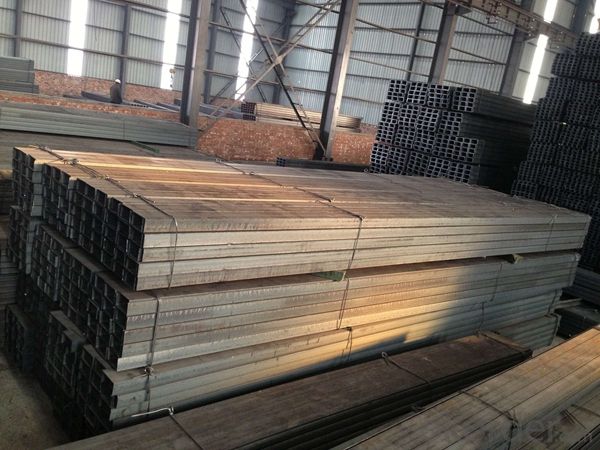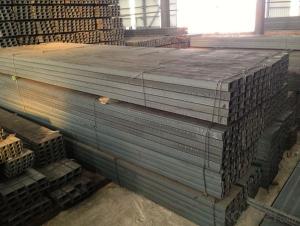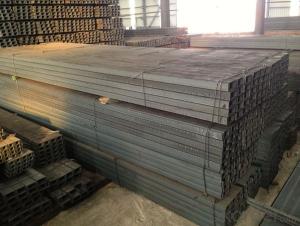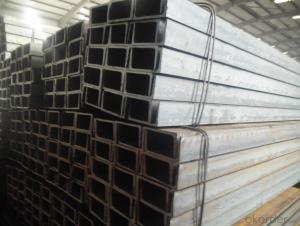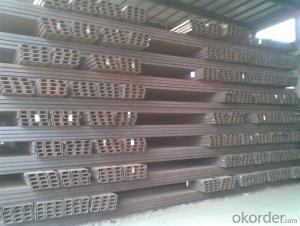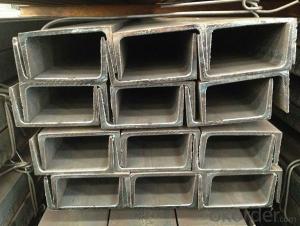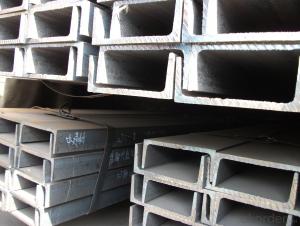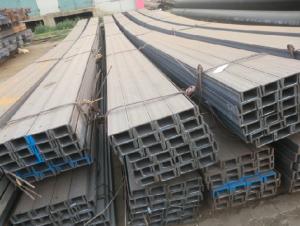Hot Rolled Mild JIS Standard U Channel for Structure Construction
- Loading Port:
- Tianjin
- Payment Terms:
- TT or LC
- Min Order Qty:
- 25 m.t.
- Supply Capability:
- 200000 m.t./month
OKorder Service Pledge
OKorder Financial Service
You Might Also Like
Product Description:
OKorder is offering Hot Rolled Mild JIS Standard U Channel for Structure Constructionat great prices with worldwide shipping. Our supplier is a world-class manufacturer of steel, with our products utilized the world over. OKorder annually supplies products to European, North American and Asian markets. We provide quotations within 24 hours of receiving an inquiry and guarantee competitive prices.
Product Applications:
Hot Rolled Mild JIS Standard U Channel for Structure Construction are ideal for structural applications and general fabricating. The steel u channel can be applied to construction of warehouses, workshops, sport stadiums and car parks etc. In details, the steel u channel belongs to carbon structural steel which is applied to in the field of construction and machinery. The steel u channel is usually used for arch-itechtural structure, and they could be welded in order to support or hang a vari-ety of facilities. They are also usually used in combination with I beam. Generally,the steel u channel must possess perfect welding property, riveting property and mechanical property and so on.
Product Advantages:
Hot Rolled MS Mild JIS Steel U Channels for Strcutures are durable, strong, and resists corrosion.
Main Product Features:
· Premium quality
· Prompt delivery & seaworthy packing (7-10 days after receiving deposit)
· Corrosion resistance
· Can be recycled and reused
· Mill test certification
· Professional Service
· Competitive pricing
Product Specifications:
1.We supply Hot Rolled Mild JIS Standard U Channel for Structure Construction at reasonable price, including Chinese standard, Japanese standard and so on.
Standard | GB/JIS |
Material Grade | Q235,SS400 |
Technique: | Hot Rolled |
Sizes as per chinese standard: | 50*37*4.5mm - 300*89*11.5mm
|
Sizes as per japanese standard: | 50*25*3mm – 200*80*7.5mm |
Length: | 6meter, 9meter, 12meter |
Note: 1.we are also competent to provide our customers other MS Channel based on other sizes according to customer’s requirements.
2. The length of our ms channel could be cut into other meters as per customer’s requirements. For example, the channel in 6meters could be cut into 5.8meters in order to be fit in the 20ft container.
2. The detailed sections of Hot Rolled Mild JIS Standard U Channel for Structure Construction as per GB standard.are shown in the table-
1:
GB U CHANNEL | Standard | Sectional | Dimension |
| Mass: |
(mm) | (mm) | (mm) | (mm) | ||
50X37 | 50 | 37 | 4.50 | 7.0 | 5.438 |
63X40 | 63 | 40 | 4.80 | 7.5 | 6.634 |
80x43 | 80 | 43 | 5.00 | 8.0 | 8.045 |
100x48 | 100 | 48 | 5.30 | 8.5 | 10.007 |
120x53 | 120 | 53 | 5.50 | 9.0 | 12.059 |
140x58 | 140 | 58 | 6.00 | 9.5 | 14.535 |
140x60 | 140 | 60 | 8.00 | 9.5 | 16.733 |
160x63 | 160 | 63 | 6.50 | 10.0 | 17.240 |
160x65 | 160 | 65 | 8.50 | 10.0 | 19.752 |
180x68 | 180 | 68 | 7.00 | 10.5 | 20.174 |
180x70 | 180 | 70 | 9.00 | 10.5 | 23.000 |
200x73 | 200 | 73 | 7.00 | 11.0 | 22.637 |
200x75 | 200 | 75 | 9.00 | 11.0 | 25.777 |
220x77 | 220 | 77 | 7.00 | 11.5 | 24.999 |
220x79 | 220 | 79 | 9.00 | 11.5 | 28.453 |
250x78 | 250 | 78 | 7.00 | 12.0 | 27.410 |
250x80 | 250 | 80 | 9.00 | 12.0 | 31.335 |
250x82 | 250 | 82 | 11.00 | 12.0 | 35.260 |
280x82 | 280 | 82 | 7.50 | 12.5 | 31.427 |
280x84 | 280 | 84 | 9.50 | 12.5 | 35.823 |
280x86 | 280 | 86 | 11.50 | 12.5 | 40.219 |
300x85 | 300 | 85 | 7.50 | 13.5 | 34.463 |
300x87 | 300 | 87 | 9.50 | 13.5 | 39.173 |
300x89 | 300 | 89 | 11.50 | 13.5 | 43.883 |
Table-1
3. The chemical composition of Hot Rolled Mild JIS Standard U Channel for Structure Construction according to Q235B is shown in Table-2.
Alloy No | Grade | Element(%) | ||||
C | Mn | S | P | Si | ||
Q235 | B | 0.12-0.20 | 0.3-0.7 | ≦0.045 | ≦0.045 | ≦0.3 |
Table-2
Note: we are able to present our customers relevant SGS test report for chemical composition of HR Channel Steel.
4. The mechanical property of HR Channel Steel according to Q235B is shown in Table-3-1 and Table-3-2
Alloy No | Grade | Yielding Strength Point(Mpa) | |||
Thickness(mm) | |||||
≦16 | >16-40 | >40-60 | >60-100 | ||
≧ | |||||
Q235 | B | 235 | 225 | 215 | 205 |
Table-3-1
Alloy No | Grade | Tensile Strength(Mpa) | Elongation After Fracture(%) | |||
Thickness(mm) | ||||||
≦16 | >16-40 | >40-60 | >60-100 | |||
≧ | ||||||
G235 | B | 375-500 | 26 | 25 | 24 | 23 |
Table-3-2
Note: we are able to present our customers relevant SGS test report for mechanical property of MS Channel as customer’s request.
Images:
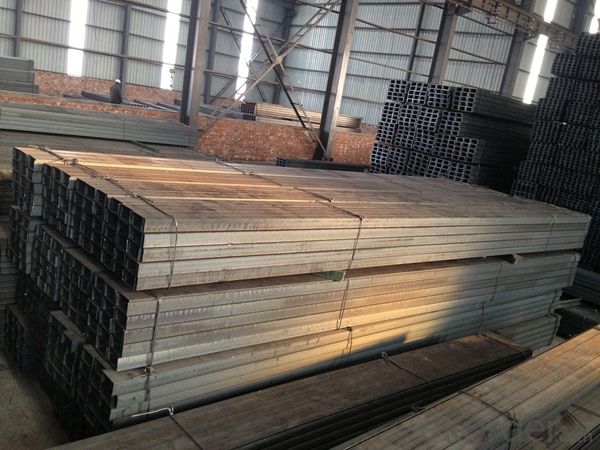
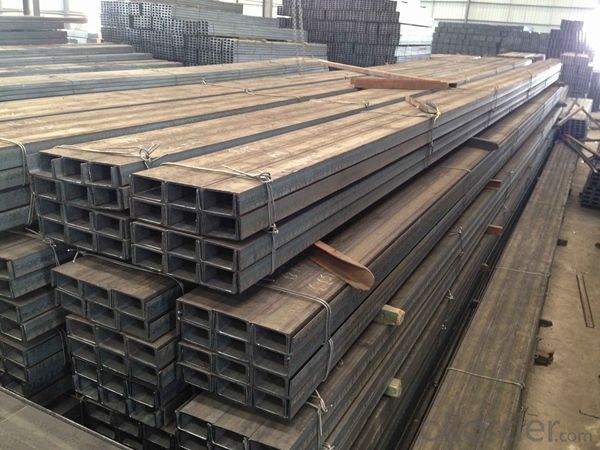
FAQ
Q1: Why buy Materials & Equipment from OKorder.com?
A1: All products offered byOKorder.com are carefully selected from China's most reliable manufacturing enterprises. Through its ISO certifications, OKorder.com adheres to the highest standards and a commitment to supply chain safety and customer satisfaction.
Q2: Can fit in the containers of 20inches the steel beams of 6M?
A2: No proble, we can put them into the containers in the form sideling.
Q3: The products are invoicing on theoritical weight or on actual weight?
A3: We can do it in both manners, according to the customers' request.
- Q: Can steel channels be used in commercial construction?
- Certainly! Steel channels have a wide range of applications in commercial construction. These versatile structural components are commonly utilized in the construction industry because of their strength, durability, and cost-effectiveness. They are frequently employed as support beams, columns, and framing elements in commercial buildings. Given their excellent load-bearing capabilities and ability to withstand heavy loads, steel channels are ideal for robust and reliable structural components needed in commercial construction projects. Moreover, steel channels can be easily customized to meet specific design requirements, providing construction flexibility. Overall, due to their strength, versatility, and suitability for various applications, steel channels are highly favored in commercial construction.
- Q: How do steel channels contribute to the overall safety of a structure?
- There are several ways in which steel channels contribute to the overall safety of a structure. To begin with, steel channels provide structural support and stability to the building. In the construction industry, they are commonly utilized as load-bearing members. This aids in the efficient and even distribution of the structure's weight. As a result, the building can withstand external forces like wind, earthquakes, and heavy loads without collapsing. The presence of steel channels creates a robust framework that enhances the building's overall safety and structural integrity. Moreover, steel channels play a critical role in fire safety. Steel is a non-combustible material, and when used as channels, it effectively prevents the spread of fire within the structure. In the event of a fire, steel channels act as fire barriers, limiting the movement of flames and heat to specific areas. This containment of fire helps minimize damage and provides occupants with more time to evacuate safely. Furthermore, steel channels exhibit exceptional resistance to corrosion and deterioration, making them highly durable and reliable. Unlike other materials, steel does not decay, distort, or degrade over time. This longevity ensures that the structure remains stable and secure in the long term, reducing the risk of accidents and structural failures. Additionally, steel channels are frequently utilized in the construction of seismic-resistant structures. Their impressive strength and flexibility allow them to absorb and dissipate seismic energy during earthquakes. This ability to withstand seismic forces helps to minimize structural damage and ensures the safety of the building's occupants. In conclusion, steel channels contribute significantly to the overall safety of a structure by providing structural support, fire resistance, durability, and seismic resistance. Their inclusion in construction enhances the stability, strength, and integrity of the building, guaranteeing the safety and well-being of its occupants.
- Q: What are the weight limitations of steel channels?
- The weight limitations of steel channels vary depending on their dimensions, thickness, and the specific grade of steel used. It is important to refer to the manufacturer's specifications or consult with an engineer to determine the maximum weight that a particular steel channel can support safely.
- Q: Can steel channels be used in telecommunications infrastructure?
- Certainly, telecommunications infrastructure can make use of steel channels. One can commonly find steel channels being employed in the construction of electrical and telecommunications towers, as well as during the installation of various equipment like antennas, cables, and support structures. The inherent strength and durability of steel render it a perfect material for supporting heavy equipment and guaranteeing the stability and longevity of telecommunications infrastructure. Moreover, steel channels can be conveniently customized and fabricated to suit specific requirements, thereby enabling efficient installation and maintenance procedures.
- Q: Steel arc bending machine can provide the best what? ` type details
- Determine the maximum section size of the channel, which is related to the power selection of the machine.
- Q: Are steel channels suitable for soundproofing?
- No, steel channels are not suitable for soundproofing as they are conductive and can transmit sound vibrations.
- Q: What are the different material specifications for steel channels?
- Steel channels are versatile structural components that are commonly used in construction and engineering projects. Their specifications vary depending on the specific application and requirements. Here are some of the different material specifications for steel channels: 1. Standard Grades: Steel channels are available in various standard grades defined by organizations like the American Society for Testing and Materials (ASTM) or the International Organization for Standardization (ISO). These grades include A36, A572, A588, and A992, among others. 2. Carbon Content: Steel channels can be categorized based on their carbon content. Low carbon steel channels (such as A36) have a carbon content of 0.25% or less, making them easily weldable and formable. High carbon steel channels (such as A588) have a carbon content above 0.25% and possess greater strength and hardness. 3. Alloying Elements: Some steel channels are alloyed with specific elements to enhance their properties. For example, stainless steel channels contain high levels of chromium, which provides corrosion resistance. Alloy steel channels may contain elements like manganese, nickel, or molybdenum to improve strength, toughness, and other desired characteristics. 4. Dimensions and Sizes: Steel channels come in various dimensions and sizes, which are specified by their height (in inches or millimeters), width (in inches or millimeters), and weight per unit length (in pounds per foot or kilograms per meter). Common sizes range from 2 inches x 1 inch to 12 inches x 20 inches or larger. 5. Surface Finish: Steel channels can have different surface finishes depending on the manufacturing process and intended use. Common surface finishes include hot-rolled, cold-rolled, galvanized, or painted. Each finish provides unique benefits such as improved strength, aesthetics, or corrosion resistance. 6. Tolerances: Steel channels typically have specified tolerances for dimensions, straightness, twist, and other parameters. These tolerances ensure that the channels meet the required standards and can be accurately fabricated and installed. It is important to consult the specific material specifications provided by manufacturers or industry standards when selecting steel channels for a particular project. These specifications ensure that the channels meet the required strength, durability, and other performance requirements for the intended application.
- Q: What is the difference between C steel, U steel and channel steel?
- Channel steel: the channel steel is a long strip steel with a cross section. Channel steel is divided into ordinary channel steel and light channel steel. Standard Specification for hot-rolled plain channel steel is 5-40#. According to the channel shape and can be divided into 4 kinds: cold bending equilateral channels, cold-formed non equilateral channel steel, cold rolled edge channels, the cold bending edge channels in accordance with the steel structure theory, should be the steel flange force, that channel should be upright, not lying. Channel steel is mainly used in building structures, vehicle manufacturing and other industrial structures, and channel steel is often used in conjunction with i-beam. See 100 million steel tube for you to answer the content, C steel, U steel and channel of the difference is clear.
- Q: Can steel channels be used for creating storage racks or shelving units?
- Absolutely, storage racks or shelving units can definitely be created using steel channels. Steel channels are renowned for their robustness and resilience, which makes them perfect for bearing substantial weights. They are effortlessly fabricated and assembled to produce durable and enduring storage solutions. The adaptability of steel channels permits customization and adjustment to fit precise storage demands, such as adjustable shelving heights or various rack arrangements. Furthermore, steel channels can endure demanding surroundings, such as warehouses, garages, or industrial settings, guaranteeing the stability and security of the storage racks or shelving units.
- Q: Can steel channels be used in soundproofing applications?
- Indeed, soundproofing applications can make use of steel channels. Often employed within the construction of walls or ceilings in soundproofing endeavors, steel channels serve as a robust and dependable framework that aids in mitigating the propagation of sound vibrations. Moreover, steel channels can serve as a mounting mechanism for soundproofing materials like acoustic panels or insulation layers, thereby augmenting the soundproofing potential of a given space. Utilizing steel channels within soundproofing applications facilitates the creation of an environment characterized by tranquility and serenity, as it curtails the transfer of noise between distinct areas.
Send your message to us
Hot Rolled Mild JIS Standard U Channel for Structure Construction
- Loading Port:
- Tianjin
- Payment Terms:
- TT or LC
- Min Order Qty:
- 25 m.t.
- Supply Capability:
- 200000 m.t./month
OKorder Service Pledge
OKorder Financial Service
Similar products
Hot products
Hot Searches
Related keywords
